人教版八年级英语下册unit1 what's the matter 1a-1c说课稿
- 格式:docx
- 大小:26.33 KB
- 文档页数:5

Unit1 What’s the matterPeriod One (Section A:1a-1c)Teaching aims:1.Knowledge aims:1)Ss can use the following words and phrases: head , ear, eye, mouth, nose,throat , neck, back, hand, arm, leg, tooth-teeth, foot-feet , matter, have a cold, stomachache, , backache, headache, toothache2)Ss can use the following sentence patterns:What’s the matter? I have a stomach./I have a sore back./I have a cold.He/She has a sore throat.What should I do? You should …2.Ability aims: Learn how to talk about health problems and give some advice3.Emotion aims: Let the Ss know keeping healthy is importantImportant & difficult points:Learn how to talk about health and give some advice.Teaching aids: computerTeaching design:Step 1 Warming-upSing an English song: If you’re happy.Step 2 Word study1. T: Are you happy?S: Yes, we are.T: When we’re happy, we can clap our hands and stamp our feet. Hands and feet are parts of our body, look at the boy, can you say other parts of our body in English?S: Yes ,I can.2.Present a picture of a baby. let the Ss say the parts of the body.3.Work on Section A 1a4. Play a game: Touch the parts of your body1)Let the whole class touch the parts of their body when teacher say: Touchyour…2)Ask six Ss to come to the front and do as the teacher tells them: Touchyour…if one does wrong, let him or her go back, the last one who in the front is the winner.(clap hands)Step 3 Presentation and practice1. T: Are you happy? Ss: Yes, we are.T: Look at the picture, is he happy?Ss: No, he isn’t.T: Why?(Help the Ss to answer: He has a stomachache.)2.Present other pictures, talk about health problems of the persons in the pictures. What’s the matter? He/She has a headache/ toothache /a sore back/ a sore throat/a cold and a cough.3. Let the Ss practice in pairs4. T: Suppose there is something wrong with your body .You may say: I have a headache. I have a sore throat.Step 4 ChantHead, head, I have a headache. I have a headache,Stomach, stomach, I have a stomachache. I have a stomachache,Ear, ear, I have an earache. I have an earache,Tooth, tooth, I have a toothache. I have a toothache.Back, back, I have a sore back. I have a sore back,Throat, throat, I have a sore throat. I have a sore throat.Oh, dear! Do more exercise, please and keep healthy!Step 5 listen and say1.Work on Section A 1b, listen and number the names 1-5.2.Listen again and talk about the health problems of the persons in the picture.Eg: Nancy has a toothache, Sarah has a cold,…Step6. PresentationGuessing gameThe teacher shows some part of the pictures to the Ss and let them guess .T: What’s the matter with him/her?S: Does he/she have a …?T: Yes, he/she has a cold. Can you give him/ her some advice? Whatshould he /she do?S: He /She should drink hot tea with honey/ shouldn’t speak more/ go to see a doctor… (Ss can give different advice as they like)T: What’s the matter with him/her?S: Does he/she have a …?T: Yes, he / she has a / an toothache /fever / headache / earache…Whatshould he /she do?S: He /She should go to see a dentist / shouldn’t eat ice cream/shouldn’tdrink cold water /lie down and rest / shouldn’t play basketball/ shoulddrink a lot of water./should see a doctor…Step7. PracticeGroup-work. Role play the conversations in 2b. Let the Ss read the conversations first. Then work in a group, make a new conversation .A: What’s the matter?B: My head feels very hot.A: Maybe you have a fever.B: What should I do?A: You should drink hot water and take some medicineStep 8 Summary。
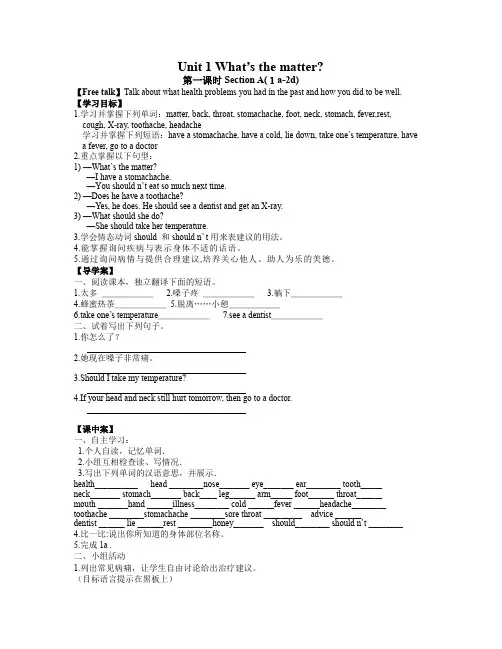
Unit 1 What’s the matter?第一课时Section A(1a-2d)【Free talk】Talk about what health problems you had in the past and how you did to be well. 【学习目标】1.学习并掌握下列单词:matter, back, throat, stomachache, foot, neck, stomach, fever,rest, cough, X-ray, toothache, headache学习并掌握下列短语:have a stomachache, have a cold, lie down, take one’s temperature, havea fever, go to a doctor2.重点掌握以下句型:1) —What’s the matter?—I have a stomachache.—You should n’t eat so much next time.2) —Does he have a toothache?—Yes, he does. He should see a dentist and get an X-ray.3) —What should she do?—She should take her temperature.3.学会情态动词should 和should n’ t用来表建议的用法。
4.能掌握询问疾病与表示身体不适的话语。
5.通过询问病情与提供合理建议,培养关心他人、助人为乐的美德。
【导学案】一、阅读课本,独立翻译下面的短语。
1.太多______2.嗓子疼______3.躺下______4.蜂蜜热茶______5.脱离……小憩______6.take one’s temperature______7.see a dentist______二、试着写出下列句子。

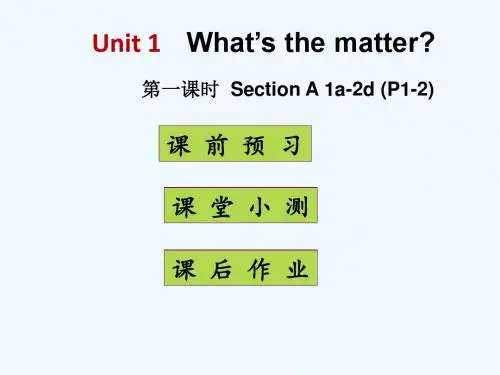
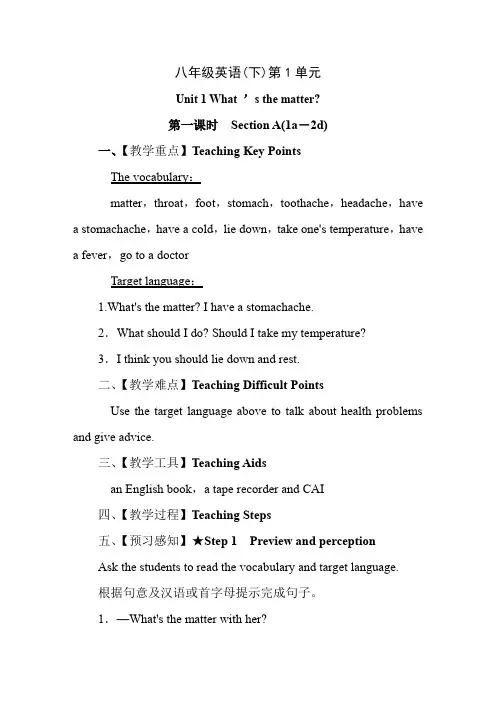
八年级英语(下)第1单元Unit 1 What ’s the matter?第一课时Section A(1a-2d)一、【教学重点】Teaching Key PointsThe vocabulary:matter,throat,foot,stomach,toothache,headache,have a stomachache,have a cold,lie down,take one's temperature,have a fever,go to a doctorTarget language:1.What's the matter? I have a stomachache.2.What should I do? Should I take my temperature?3.I think you should lie down and rest.二、【教学难点】Teaching Difficult PointsUse the target language above to talk about health problems and give advice.三、【教学工具】Teaching Aidsan English book,a tape recorder and CAI四、【教学过程】Teaching Steps五、【预习感知】★Step 1Preview and perceptionAsk the students to read the vocabulary and target language.根据句意及汉语或首字母提示完成句子。
1.—What's the matter with her?—She has a very sore t______ now.2.He ate too much,so he had a s______.3.If you feel tired,you should l______ down and rest.4.If you ______(咳嗽),drink some hot tea with honey.5.He wants to see a dentist,because he has a ______(牙疼).★Step 2Consociation and exploration【合作探究】Let the students read the book by themselves in order to find out the answers.They can discuss the questions in groups or ask the teacher for help.When they finish the questions,ask some students to check the answers.★Step 3Leading in【情景导入】Ask a student to act something is wrong with his/ her head…And T:What's the matter?Help the students to answer:I have a…Have the students repeat.★Step 4Pre-task【准备任务】Page 1,1a &1b1.Look at the picture.Write the correct letter [a-m] for each part of the body.2.Match each activity.3.Play the tape and ask the students to listen and find the answers.Page 1,1c1.Focus on the conversation in the box.2.Practice reading.3.Pairwork:Ask the students to look at the picture and practice in pairs like this:S1:What's the matter?S2:I have…4.Groupwork: Divide the class into some groups.Make conversations.S1:What's the matter?S2:She talked too much yesterday and didn't drink enough water.She has a very sore throat now.S3:…★Step 5While-task【过程任务】Page 2,2a&2b1.Play the recording for the first time.Students listen and number the pictures [1-5] in order.2.Check the answers.3.Play the recording a second time and say:There are five conversations.Some have some problems and the others give them some advice.Listen and match the problems with the advice.★Step 6Post-task【后续任务】Page 2,2c & 2d1.Focus on the conversation in 2c & 2d.2.Practice reading.Make the students scan the conversations first.3.Teach and then make the students role-play the conversation in pairs.4.Play the recording and ask the students to listen and repeat 2d.★Step 7Consolidation practice【巩固练习】Look at the students' book of the 1st exercise.★Step 8Summary【课堂小结】In this class we should master “matter,stomach,toothache,headache,have a stomachache,have a cold,take one's temperature”and some sentences in target language.★Step 9Homework【家庭作业】1.Listen to the tapes twice.2.Practice the conversation on Page 2,2d.Board Design板书设计Unit 1What's the matter?The first period Section A(1a-2d)1.Key vocabulary:have a stomachache;have a cold; lie down;take one's temperature;have a fever;go to a doctor2.Target language:(1)What's the matter? I have a stomachache.(2)What should I do? Should I take my temperature?(3)I think you should lie down and rest.。
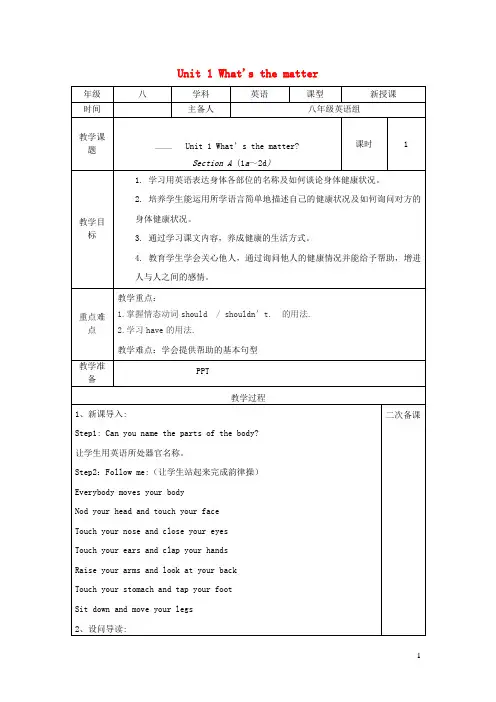
Unit 1 What's the matter年级八学科英语课型新授课时间主备人八年级英语组教学课题Unit 1 What’s the matter?Section A (1a~2d)课时 1教学目标1. 学习用英语表达身体各部位的名称及如何谈论身体健康状况。
2. 培养学生能运用所学语言简单地描述自己的健康状况及如何询问对方的身体健康状况。
3. 通过学习课文内容,养成健康的生活方式。
4. 教育学生学会关心他人,通过询问他人的健康情况并能给予帮助,增进人与人之间的感情。
重点难点教学重点:1.掌握情态动词should / shouldn’t.的用法.2.学习have的用法.教学难点:学会提供帮助的基本句型教学准备PPT教学过程1、新课导入:Step1: Can you name the parts of the body?让学生用英语所处器官名称。
Step2:Follow me:(让学生站起来完成韵律操)Everybody moves your bodyNod your head and touch your faceTouch your nose and close your eyesTouch your ears and clap your handsRaise your arms and look at your backTouch your stomach and tap your footSit down and move your legs2、设问导读:二次备课4. 如果你的头和脖子明天仍然疼的话,请去看医生。
五.拓展探究Homework: Make up a conversation between a doctor and a patient.课堂小结本课通过身体器官韵律操导入课时内容,激发学生的学习兴趣,提高课堂教学的效率,同时针对学生日常生活中的常见症状,让学生在列举过程中掌握患病方式的三种表达方式。

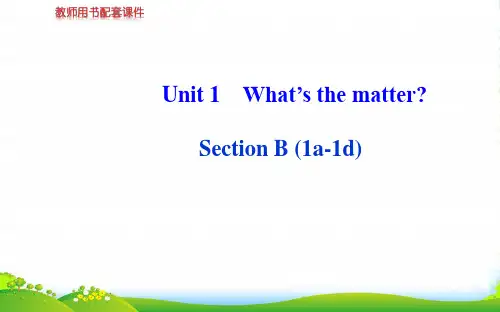
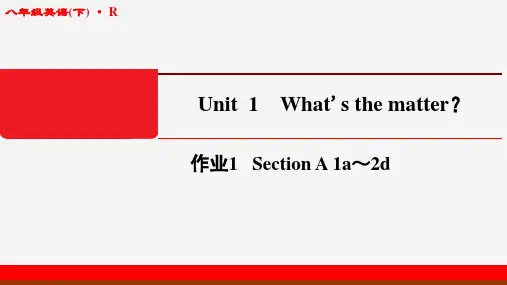
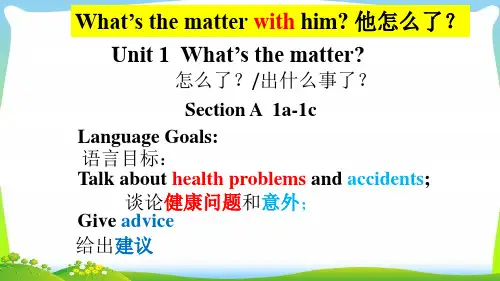
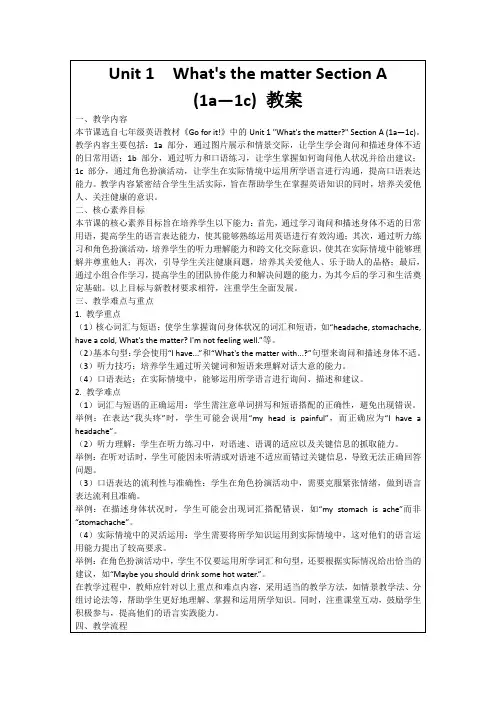
尊敬的各位领导,评委老师:大家下午好!今天我说课的内容是PEP八年级英语下册 Unit1what’s the matter?Part A( 1a-1c )部分。
下面我将从教材、学情、教法学法、教学过程和简要的板书设计及反思这六个方面展开我的说课。
一、说教材1、教材的内容和地位(1)教材是以“What’s the matter?为中心话题,学习谈论健康状况及如何针对身体不适问题提出建议,并倡导人们养成健康饮食及良好的生活习惯。
教育学生注意饮食习惯,关心他人。
在学习中,学生通过对身体不适的描述及建议,促进学生之间和师生之间的情感交流,增进情谊。
(2)本节是本单元的重点内容,主要学习人体各个部位名称及询问对方的身体状况,使学生学会关心他人。
2、新课标要求新课程标准明确指出要发展学生综合运用语言的能力,培养学生的交际能力。
3、教学目标根据教学大纲和学生的实际情况,我制定如下教学目标:(1)。
知识目标:A.识记人体各个部位的名称及如何谈论身体健康状况B。
运用"What's the matter…?”“I have/get …”句型在日常生活中进行对话(2)。
能力目标:培养学生能运用所学语言简单的描述自己的健康状况及如何询问对方的身体健康状况。
提高学生的听、说、读综合能力。
(3)情感、态度和价值观教育学生要学会关心他人,通过询问他人的健康情况并能给予帮助,增进人与人之间的感情。
让学生感受到学英语最主要是为了在现实生活中进行交流,而不是单纯的为了英语课和应付考试而学习。
4、教学重难点根据教学大纲的要求,及本课在教材的地位及作用。
我确定以下重、难点:重点:学习人体各个部位的名称及如何询问和回答身体的健康状况。
难点:有“What’s the matter?/ What's wrong?”“I have/get a sore throat…"句型在实际生活中的应用。
二、说学情八年级的学生对英语已经有一定的基础,但对于乡镇中学的学生来说,大部分学生学习英语的兴趣不是很浓,在学习中他们更喜欢从游戏或活动中学习。
Unit 1 What's the matter?第一课时Section A (1a~2d)【基础知识】1. matter(1) n. 事情;问题;毛病;麻烦事。
What's the matter? 表示"怎么了?" "出了什么事?"这是询问对方遇到什么困难(麻烦) ,特别是询问疾病的表达方式。
What's the matter (with sb.)? = What's wrong (with sb.)?= What's the problem/trouble (with sb. )? = What's up (with sb.)?(2) v.有关系;要紧。
常用于否定句和疑问句,一般以it为主语。
eg: It doesn't matter. 没关系。
/不要紧。
2. have表示"患(病)",用于下列结构:have a +病名,其中have相当于catch。
eg: have a (bad) cold 患(重)感冒have a stomachache胃痛have a sore back 背痛have a toothache 牙痛have a fever 发烧have colds 感冒have a headache头痛have a sore throat喉咙痛3. enough water意为"足够的水"。
enough为形容词。
多位于被修饰的名词之前。
eg: I have enough money. 我有足够的钱。
4. foot n.脚;足。
其复数为feet。
5. lie v.躺;平躺。
lie → lying(现在分词)→lay(过去式)。
6. 其他重点短语hot tea with honey 加蜂蜜的热茶see a dentist看牙医take one' s temperature量体温take breaks/a break 休息go to a doctor 看医生【基础训练】I. 根据句意及首字母提示填写单词。
Unit1 What’s the matter?第一课时Section A 1a—2d【Study-aims】知识目标:1. 掌握人体部位及身体症状的单词。
2. 掌握下列句型--- What’s the matter (with you)?---I have a …--- What’s the matter with her/him? ---She/He has a…You should …. You shouldn’t ….能力目标:学会询问他人病情,会填写病历表并提出相应的建议。
情感目标:主动去救助处于危险境地的人,在生死抉择之际,要有勇气做出正确的决定。
学习策略:综合培养学生与别人交流和沟通的能力。
文化意识:让学生更多的了解中西方的就医、关心、建议的表达及公德意识的培养。
【Key & difficult points】询问某人的健康问题及遇到麻烦的表达方法。
情态动词should的用法。
【Learning procedure】I. Pre-class1. 翻译下列短语1) 感冒2) 胃疼3) 喉咙痛4) 躺下5) 加有蜂蜜的热茶6) 头疼7) 量体温8) 躺下休息9) 看牙医10)做一个X光检查11) 割伤自己12) 发烧13) 整个周末14)去看医生2. 知识超市:1) matter为可数名词,意为“毛病;麻烦事”,通常用于句型What’s the matter (with sb)?中。
该问句常用来询问某人患了何种疾病或遇到了何种麻烦。
Eg: ——What’s the matter with him?他怎么了?——He has a headache. 他头痛。
matter还可作不及物动词,意为“要紧;有关系”Eg: It does n’t matter. 没有关系2. Learning the new knowledge(1)学会谈论询问某人的健康问题及遇到麻烦的表达方法。
2) I have a cold. 我感冒了。
Unit 1 What’s the matter?Period 1 Section A (1a-2d)必背单词1. matter n.问题;事情2. foot n.脚;足→ feet ( 复数)3. neck n.颈;脖子4. stomach n.胃;腹部→ stomachache n.胃痛;腹痛5. throat n.咽喉;喉咙6. fever n.发烧→ have a fever 发烧7. lie v.躺;平躺→ lay(过去式)→ lain(过去分词)→ lying(现在分词)8. rest v.& n.放松→ take/have a rest 休息一下9. cough n.&v.咳嗽→ have a cough 咳嗽10. X-ray n. X 射线;X 光→ take an X-ray 拍X 光片11. toothache n.牙痛→ tooth n.牙齿12. headache n.头痛→ have a headache 头痛13. break n.间歇;休息14. hurt v.(使)疼痛;受伤→hurt(过去式、过去分词)必背短语15. have a cold/stomachache 感冒/ 胃痛16. lie down 躺下17. take one’s temperature 量体温18. take breaks=take a break 休息必背句子19. Yeah, I think I sat in the same way for too long without moving.是啊,我想我保持同样的坐姿太久了而没动。
20. If your head and neck still hurt tomorrow, then go to a doctor.如果明天你的头和脖子还疼的话,就去看医生吧。
Period 2 Section A (3a-3c)必背单词1. passenger n.乘客2. off adv.& prep.离开(某处);不工作;从……去掉→ have a day off 休假一天3. onto prep.向;朝4. trouble n.问题;苦恼→ have trouble (in) doing sth. 做某事有困难5. hit v.(用手或器具)击;打→ hit(过去式)必背短语6. think twice 认真思考,权衡利弊7. get off 下车→ get on 上车8. wait for 等待;等候9. to one’s surprise 使……惊讶的是;出乎……的意料10. thanks to 多亏;由于→ thanks for 因……而感谢11. in time 及时→ on time 准时12. right away=at once 立即;马上13. agree to do sth. 同意做某事→ agree with sb. 同意某人(的意见或观点等)14. get into 陷入;参与必背句子15. She said that the man had a heart problem and should go to the hospital.她说这位老人有心脏病,应该去医院。
尊敬的各位领导,评委老师:
大家下午好!今天我说课的内容是PEP八年级英语下册 Unit1what’s the matter?Part A( 1a-1c )部分。
下面我将从教材、学情、教法学法、教学过程和简要的板书设计及反思这六个方面展开我的说课。
一、说教材
1、教材的内容和地位
(1)教材是以“What’s the matter?为中心话题,学习谈论健康状况及如何针对身体不适问题提出建议,并倡导人们养成健康饮食及良好的生活习惯。
教育学生注意饮食习惯,关心他人。
在学习中,学生通过对身体不适的描述及建议,促进学生之间和师生之间的情感交流,增进情谊。
(2)本节是本单元的重点内容,主要学习人体各个部位名称及询问对方的身体状况,使学生学会关心他人。
2、新课标要求
新课程标准明确指出要发展学生综合运用语言的能力,培养学生的交际能力。
3、教学目标
根据教学大纲和学生的实际情况,我制定如下教学目标:
(1).知识目标:
A.识记人体各个部位的名称及如何谈论身体健康状况
B.运用”What’s the matter…?”“I have/get …”句型在日常生活中进行对话
(2).能力目标:
培养学生能运用所学语言简单的描述自己的健康状况及如何询问对方的身体健康状况。
提高学生的听、说、读综合能力。
(3)情感、态度和价值观
教育学生要学会关心他人,通过询问他人的健康情况并能给予帮助,增进人与人之间的感情。
让学生感受到学英语最主要是为了在现实生活中进行交流,而不是单纯的为了英语课和应付考试而学习。
4、教学重难点
根据教学大纲的要求,及本课在教材的地位及作用。
我确定以下重、难点:
重点:学习人体各个部位的名称及如何询问和回答身体的健康状况。
难点:有“What’s the matter?/ What’s wrong?”“I have/get a sore throat…”句型在实际生活中的应用。
二、说学情
八年级的学生对英语已经有一定的基础,但对于乡镇中学的学生来说,大部分学生学习英语的兴趣不是很浓,在学习中他们更喜欢从游戏或活动中学习。
针对这一情况,我在课堂上创造外语语言氛围,激发学生学习英语的兴趣;让学生在参与英语各项活动时,能够更好地掌握知识;同时通过对话来进行训练,巩固所学的知识。
让学生在乐中学,轻松地掌握所学知识。
三、说教法学法
作为一个引导者、组织者,我遵循新课程“学生是学习的主人,一切的教学活动设计在以学生为本”的教学理念,坚持“为学生的发展,必须培养学生的自主性、能动性、独立性和创造性”的教学原则。
课堂上我采用了多媒体、图片、和肢体动作来辅助教学,增加了直观性、活跃性和趣味性。
通过任务型教学法,,图片展示法等去引导学生学习。
学生通过在参与各种活动中学习知识。
学生在轻松的气氛里掌握知识,达到最佳的教学效果。
四、说教学过程
Step 1 Warming-up
(设计意图:让同学跟着视频音乐和里面的人物做warming-up活动,通过全方位的运动,全感官的放松,为学生创造轻松愉快的学习气氛,激发学生的好奇心,为学习新课拉开了完美的序幕。
让学生很快融入到英语学习的氛围中,同时为下面引出身体各部位名称的教学作铺垫。
)
Step 2 Word study
(设计意图:用明星的图片激发学生的兴趣,用图片来教学新的单词,直观、形象生动,有利于单词的巩固记忆。
)
Step 3 Practice
检查学生对身体部位单词的掌握情况。
Step 4 Presentation and practice
(设计意图:以happy这个单词自然地引出the wo man who’s not happy because she has a cold.为下面引出其他人的种种不适做铺垫。
)
What’s the matter? He/She has a headache/ toothache /stomachache /a sore back/ a sore throat.
(设计意图:用形象生动的图片来引出本课要掌握的句型,有利于学生对新知识的掌握。
)
3. Grammar focus.
呈现完新句型后,我把重点知识点予以整合。
(设计意图:对重难点知识提炼与整合,让学生更好的对重点知识系统性的记忆,加深印象。
)
4. Practice(对话练习)
(设计意图:以对话的形式来操练句型,巩固新句型的使用。
从第三人称过渡到第一人称,对学生来说是简单了。
)
Step 5 listening
听之前分析内容
(设计意图:作好听力前的铺垫对于学生提高正确率非常重要,所以在听前对图片和任务的分析很有必要,为学生接下来的听力任务打下了基础。
)
在整体感知后,我把听力截成五个对话部分,让学生用填空的方式完成表格,从而为下面的1c对话练习做好铺垫。
Step 6 Speaking
结合1b的表格再让学生仿照1c的例句造句,让更多的学生有表达的机会。
Step 7 Exercises
1.Fill the blanks
2.look and say
3.Translate
有词到短语再到句子分层练习,让知识递进,有层次性,学生更容易接受。
Step 8 Summary
1.Ask students to sum up the parts of a body and the names of illness.
2.询问健康问题的句型有:What’s the matter with…?
3.回答健康问题可用:I have a…She has a …
五、说板书设计
Unit 1 What’s the matter?
Period 1 Section A (1a-1c)
What’s the matter with sb.?
cold foot(feet)
sore back back
sore throat throat
sb. have/has a
head ache head
Stomach ache stomach
Tooth ache tooth(teeth)
板书设计以简单明了为主,把重点知识呈现在黑板上,让学生一目了然,同时我注重了单词与短语之间的相互呼应,更有对比性。
六、说教学反思
教学亮点:我注重培养了学生的朗读能力和英语交流的能力,并通过听、说、做等活动激发学生的学习兴趣,鼓励他们大胆说,逐步帮助他们养成良好的学习习惯,发展自主学习的能力,为下一步学习打下了基础。
教学不足:情境课堂的开展,更多适用于相对积极踊跃的孩子们,参与的积极性高,效果显著。
相反,对于性格内向且不爱发言、表达表演能力相对薄弱的孩子们来说,在活动方法上应继续有所改进。